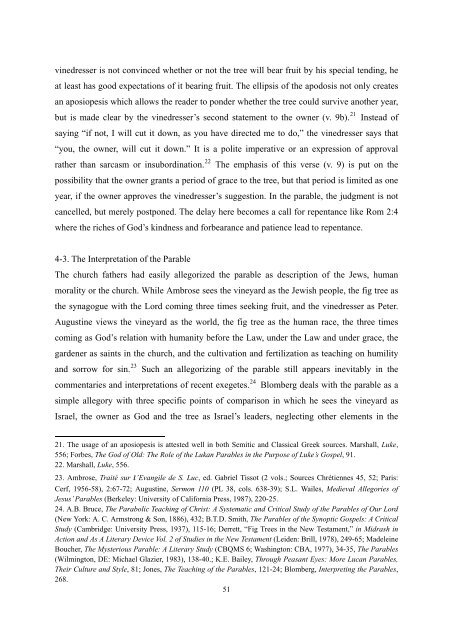the role of the lukan parables in terms of the purpose of luke's gospel
the role of the lukan parables in terms of the purpose of luke's gospel
the role of the lukan parables in terms of the purpose of luke's gospel
You also want an ePaper? Increase the reach of your titles
YUMPU automatically turns print PDFs into web optimized ePapers that Google loves.
v<strong>in</strong>edresser is not conv<strong>in</strong>ced whe<strong>the</strong>r or not <strong>the</strong> tree will bear fruit by his special tend<strong>in</strong>g, he<br />
at least has good expectations <strong>of</strong> it bear<strong>in</strong>g fruit. The ellipsis <strong>of</strong> <strong>the</strong> apodosis not only creates<br />
an aposiopesis which allows <strong>the</strong> reader to ponder whe<strong>the</strong>r <strong>the</strong> tree could survive ano<strong>the</strong>r year,<br />
but is made clear by <strong>the</strong> v<strong>in</strong>edresser’s second statement to <strong>the</strong> owner (v. 9b). 21 Instead <strong>of</strong><br />
say<strong>in</strong>g “if not, I will cut it down, as you have directed me to do,” <strong>the</strong> v<strong>in</strong>edresser says that<br />
“you, <strong>the</strong> owner, will cut it down.” It is a polite imperative or an expression <strong>of</strong> approval<br />
ra<strong>the</strong>r than sarcasm or <strong>in</strong>subord<strong>in</strong>ation. 22<br />
The emphasis <strong>of</strong> this verse (v. 9) is put on <strong>the</strong><br />
possibility that <strong>the</strong> owner grants a period <strong>of</strong> grace to <strong>the</strong> tree, but that period is limited as one<br />
year, if <strong>the</strong> owner approves <strong>the</strong> v<strong>in</strong>edresser’s suggestion. In <strong>the</strong> parable, <strong>the</strong> judgment is not<br />
cancelled, but merely postponed. The delay here becomes a call for repentance like Rom 2:4<br />
where <strong>the</strong> riches <strong>of</strong> God’s k<strong>in</strong>dness and forbearance and patience lead to repentance.<br />
4-3. The Interpretation <strong>of</strong> <strong>the</strong> Parable<br />
The church fa<strong>the</strong>rs had easily allegorized <strong>the</strong> parable as description <strong>of</strong> <strong>the</strong> Jews, human<br />
morality or <strong>the</strong> church. While Ambrose sees <strong>the</strong> v<strong>in</strong>eyard as <strong>the</strong> Jewish people, <strong>the</strong> fig tree as<br />
<strong>the</strong> synagogue with <strong>the</strong> Lord com<strong>in</strong>g three times seek<strong>in</strong>g fruit, and <strong>the</strong> v<strong>in</strong>edresser as Peter.<br />
August<strong>in</strong>e views <strong>the</strong> v<strong>in</strong>eyard as <strong>the</strong> world, <strong>the</strong> fig tree as <strong>the</strong> human race, <strong>the</strong> three times<br />
com<strong>in</strong>g as God’s relation with humanity before <strong>the</strong> Law, under <strong>the</strong> Law and under grace, <strong>the</strong><br />
gardener as sa<strong>in</strong>ts <strong>in</strong> <strong>the</strong> church, and <strong>the</strong> cultivation and fertilization as teach<strong>in</strong>g on humility<br />
23<br />
and sorrow for s<strong>in</strong>. Such an allegoriz<strong>in</strong>g <strong>of</strong> <strong>the</strong> parable still appears <strong>in</strong>evitably <strong>in</strong> <strong>the</strong><br />
commentaries and <strong>in</strong>terpretations <strong>of</strong> recent exegetes. 24<br />
Blomberg deals with <strong>the</strong> parable as a<br />
simple allegory with three specific po<strong>in</strong>ts <strong>of</strong> comparison <strong>in</strong> which he sees <strong>the</strong> v<strong>in</strong>eyard as<br />
Israel, <strong>the</strong> owner as God and <strong>the</strong> tree as Israel’s leaders, neglect<strong>in</strong>g o<strong>the</strong>r elements <strong>in</strong> <strong>the</strong><br />
21. The usage <strong>of</strong> an aposiopesis is attested well <strong>in</strong> both Semitic and Classical Greek sources. Marshall, Luke,<br />
556; Forbes, The God <strong>of</strong> Old: The Role <strong>of</strong> <strong>the</strong> Lukan Parables <strong>in</strong> <strong>the</strong> Purpose <strong>of</strong> Luke’s Gospel, 91.<br />
22. Marshall, Luke, 556.<br />
23. Ambrose, Traité sur ι’Evangile de S. Luc, ed. Gabriel Tissot (2 vols.; Sources Chrétiennes 45, 52; Paris:<br />
Cerf, 1956-58), 2:67-72; August<strong>in</strong>e, Sermon 110 (PL 38, cols. 638-39); S.L. Wailes, Medieval Allegories <strong>of</strong><br />
Jesus’ Parables (Berkeley: University <strong>of</strong> California Press, 1987), 220-25.<br />
24. A.B. Bruce, The Parabolic Teach<strong>in</strong>g <strong>of</strong> Christ: A Systematic and Critical Study <strong>of</strong> <strong>the</strong> Parables <strong>of</strong> Our Lord<br />
(New York: A. C. Armstrong & Son, 1886), 432; B.T.D. Smith, The Parables <strong>of</strong> <strong>the</strong> Synoptic Gospels: A Critical<br />
Study (Cambridge: University Press, 1937), 115-16; Derrett, “Fig Trees <strong>in</strong> <strong>the</strong> New Testament,” <strong>in</strong> Midrash <strong>in</strong><br />
Action and As A Literary Device Vol. 2 <strong>of</strong> Studies <strong>in</strong> <strong>the</strong> New Testament (Leiden: Brill, 1978), 249-65; Madele<strong>in</strong>e<br />
Boucher, The Mysterious Parable: A Literary Study (CBQMS 6; Wash<strong>in</strong>gton: CBA, 1977), 34-35, The Parables<br />
(Wilm<strong>in</strong>gton, DE: Michael Glazier, 1983), 138-40.; K.E. Bailey, Through Peasant Eyes: More Lucan Parables,<br />
Their Culture and Style, 81; Jones, The Teach<strong>in</strong>g <strong>of</strong> <strong>the</strong> Parables, 121-24; Blomberg, Interpret<strong>in</strong>g <strong>the</strong> Parables,<br />
268.<br />
51
















